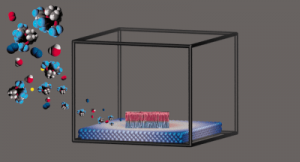 The development of novel advanced materials and their application in devices requires large scale, precise synthesis techniques, such as the widely used chemical vapor deposition (CVD). During the molecule-to-material conversion that takes place in the CVD process, gas phase precursors react on a thermally activated growth substrate, or are already activated in the plasma phase through collisions with “hot” electrons. Current CVD technologies are mainly based on empirical knowledge, while the theoretical modeling of this process is challenging due to its complexity at a molecular level. Facing this challenge may not only contribute to the knowledge-driven design of new synthesis strategies for new materials but also might foster further development in theoretical methodologies.
The development of novel advanced materials and their application in devices requires large scale, precise synthesis techniques, such as the widely used chemical vapor deposition (CVD). During the molecule-to-material conversion that takes place in the CVD process, gas phase precursors react on a thermally activated growth substrate, or are already activated in the plasma phase through collisions with “hot” electrons. Current CVD technologies are mainly based on empirical knowledge, while the theoretical modeling of this process is challenging due to its complexity at a molecular level. Facing this challenge may not only contribute to the knowledge-driven design of new synthesis strategies for new materials but also might foster further development in theoretical methodologies.
“Modeling CVD processes”, says Dr. Gloria Tabacchi, from Insubria University, Italy, “might seem a nearly impossible task, however the issue is so fascinating and the problems so tough that one might be forced to invent novel strategies to solve them.”
In a perspective article published in the International Journal of Quantum Chemistry, Tabacchi and co-workers review the main issues in first principles modeling of the CVD process, related to both the precursors and their reactivity, and to the interaction between the growth substrate, the precursor molecule, and other gaseous species that may be present under the CVD operating conditions. Computational studies of the precursor chemistry are hindered by the large size of the system and the frequent presence of transition metals, whose theoretical treatment is still problematic. A combination of computational techniques with different accuracy is presented as the most promising strategy currently available to tackle these issues. Other challenges are related to the growth substrate, whose modeling must reflect temperature and surface structure/composition effects, as well as the possible influence of the reaction atmosphere. Despite the complexity, smart combinations of first principles molecular dynamics and tight-binding molecular dynamics are proving successful to reveal new reaction and diffusion processes of CVD at the molecular level. However, concludes Tabacchi, it is only by combining theoretical and experimental strategies that real insight in the complex microscopic aspects of the molecule-to-material transformation processes can be achieved.

















